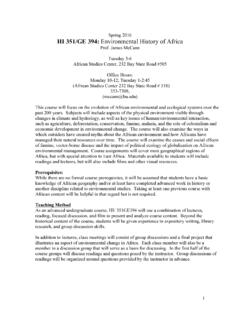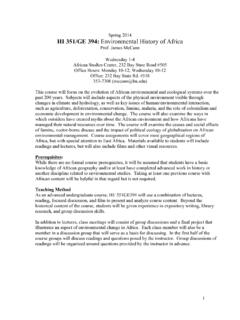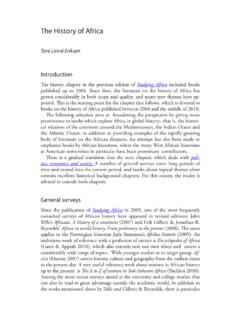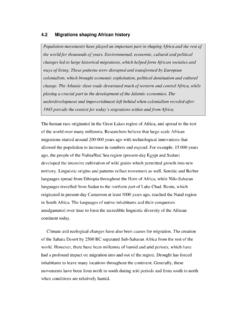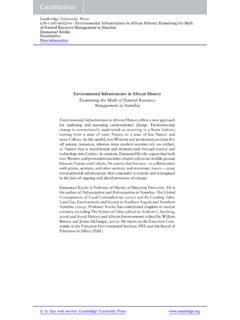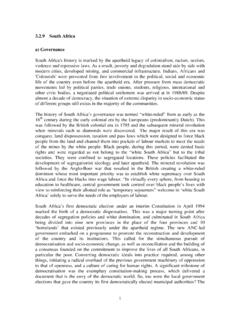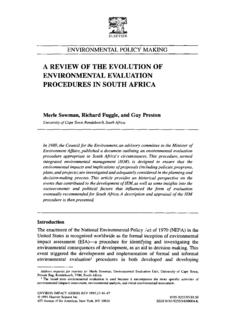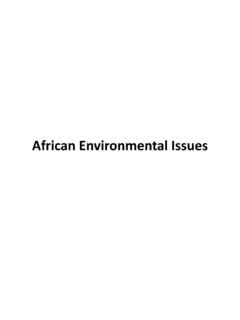Transcription of The Social and Environmental Consequences of …
1 The Social and Environmental Consequences of Coal Mining in South africa A CASE STUDY Prepared by: Victor Munnik (Mvula Trust) with Geraldine Hochmann (Mvula Trust), Mathews Hlabane (SA Green Revolutionary Council) and Stephen Law ( Environmental Monitoring Group) January 2010 A joint initiative of Environmental Monitoring Group, Cape Town, South africa and Both ENDs, Amsterdam, The Netherlands Copyright : Environmental Monitoring Group Page 1 of 24 Contents Coal mining in South South African coal export and Dutch coal The politics of coal Coal dynamic on the Mpumalanga Legislation and regulation of coal Water Air pollution from coal mining and coal Climate change and the political importance of coal Coal miners health and labour Biodiversity effects of current coal mine Community Case Community Democracy, regulation, rule of Conclusions.
2 The Environmental Page 2 of 24 Acronyms AMD Acid mine drainage ANC African National Congress BEE Black Economic Empowerment D&O Mines Derelict and Abandoned Mines DEAT Department of Environmental Affairs and Tourism DME Department of Minerals and Energy DWAF Department of Water Affairs and Forestry EIA Environmental Impact Assessment EMP Environmental Management Programmes EMPR Environmental Management Programme Report HIV/Aids Human immunodeficiency virus/Acquired immune deficiency syndrome LTMS Long Term Mitigation Scenarios MMSD, Mining, Minerals and Sustainable Development MPRDA Minerals and Petroleum Resources Development Act Mt/a million tons per year MW Megawatt NEDLAC National Economic Development and Labour Council NEMA National Environmental Management Act NGO Non government organisation NWA National Water Act pH a measure of the acidity (low pH) or basicity (high pH) of a solution PM particulate matter (breathable)
3 RBCT Richards Bay Coal Terminal SA South africa WESSA Wildlife and Environment Society of SA Page 3 of 24 Introduction This case study focuses on the costs of the Environmental and Social effects of coal mining in South africa , undertaken for export to the Netherlands. Coal mining imposes many external costs on its surroundings and the people who live in it. Some of these can be quantified by estimates, others are difficult to estimate. Coal mining is by nature disturbing and destructive of the environment.
4 Open cast mining removes large volumes of soil and rock overburden to get to the workable coal seams, and destroys regional aquifers. Mining produces large mountains of solid waste. Coal heaps are prone to spontaneous combustion. Leachate from waste heaps are often acidic, adding to the general and large scale acid mine drainage impact and interferes with underground and surface water. Mining also has serious Social Consequences : on the movement of people, on people s health and the environments they live in. Page 4 of 24 The case study looks at air pollution, water quality issues, biodiversity effects, climate change effects, community responses, mine companies engagement with these responses, and the issues of coal miners.
5 It is based on desk top research, interviews, and interactions with affected communities and activists in the Witbank-Middelburg-Ermelo area, South africa s most intensely worked coalfield. A number of coal mine managers, coal companies and the Chamber of Mines were approached, but chose not to respond. Mine publicists generally point to the positive impacts of mining, like job creation and spin-off businesses. It is a sobering thought that only 41% of the income from economic activities in the area, chief of which is coal mining, remains in the area1.
6 What remains behind is land that is mostly not rehabilitated for agricultural use, although some is, rivers like the Olifants polluted with acid mine drainage, areas of soil subsidence and underground fires, air pollution from dust and the associated effects of coal fired power stations with inadequate pollution control, and coal miners suffering the effects of silicosis, tuberculosis and other occupational diseases. Coal mining in South africa It was mining that gave South africa its current shape through processes from the 1880s to 1910.
7 Gold mining took centre stage early, both because of its importance for the British and thus global monetary system and the profits to be made. Cheap black labour, achieved via the migrant labour system (in which mineworkers left their families behind and lived in all male, strictly controlled compounds), required political control. Early conflict between gold companies and Paul Kruger s Transvaal Republic about access to water, railroad transport and dynamite concessions, led to the Anglo Boer War and the consolidation of four independent provinces into a single South African state in 1910.
8 At the core of this state is a minerals energy complex2, centred on the South African Chamber of Mines, which was formed in 1887, with its object the promotion and protection of the mining interest 3. In 1980, the Department of Minerals and Energy (DME) was formed with the express mandate to promote mining. Gold mining had to deal with deep, low grade ore requiring large capital and cheap labour to keep costs down. The concentration of capital in gold mining gave the South African economy its basic structure organized around six dominant groupings of capital which extend into manufacture, banking and retail, but have at their basis a historic investment in mining.
9 Coal mining played a supportive role as provider of energy to the growing gold mining industry and indeed, many collieries were historically and are today owned by gold mining companies. To these coal mine owners it was more important to keep the costs of their own energy inputs low, than to profit from coal mining itself4. The coal price remained very low until the mid 1970s, when export opportunities opened up through a deep terminal in Richards Bay, and Japanese long term contracts. The low coal price was accompanied by harsh working conditions and low wages for African workers, a tendency to mine only the best coal ( picking out the eyes in mining jargon) instead of mining the whole seam, and a disregard for Environmental impacts.
10 Page 5 of 24 According to official statistics5 (DME (Department of Minerals and Energy), around 77 percent of South africa 's primary energy needs are provided by coal. Coal is used for electricity generation, the production of synthetic fuel by Sasol (itself a very dirty process) and used in industry and homes. Around 28 percent of South africa 's production is exported, mainly through the Richards Bay Coal Terminal, making South africa the fourth-largest coal exporting country in the world. South africa s coal reserves lie in 18 coal fields.)
